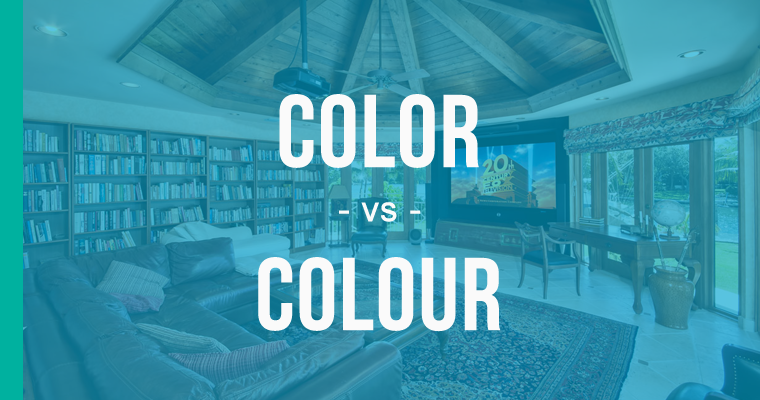Color vs. Colour – How to Use Each Correctly

What’s the Difference Between Color and Colour?
Contents
Color and colour are alternate spellings of the same word. The former is the preferred spelling for American English, while the latter is the preferred spelling for British English. They are used in all the same contexts but by different language communities.
As a noun, it refers to the pigment of something, such as red, orange, yellow, green, blue, or purple. As a verb, it means to add color to something.
The American spelling lacks the letter u.
- The colors in the painting are so beautiful! (American spelling)
The British spelling includes the letter u.
- That colour looks very fetching on you. (British spelling)
The original English spelling was the British version. However, the shorter, American has become more and more common over the years.
Let’s look at the usage of these two words.
Using Color in a Sentence
When to use color: This noun describes the hue or shade of different objects. It is related to the way that an object reflects light. The verb means the action of adding color to something.
For example,
- My favorite color is blue. (noun)
- The child colored the pages of the book. (verb)
Color appears in many different idioms, as shown below:
- a horse of a different color: something totally different
- Oh, you want to borrow one dollar? That’s fine. I thought you wanted to borrow one thousand dollars. That’s a horse of a different color.
- to pass with flying colors: to pass with an excellent grade or very high score
- Although she was initially worried about taking the test, she ended up passing with flying colors.
- color inside the lines: to follow the rules without ever straying from them
- He’s a good employee and always colors inside the lines. However, he’s not very creative.
- off color: to feel a little sick or to be rude or vulgar
- Sorry I can’t come into the office today, but I feel a little off color.
- Off-color jokes are not appreciated in formal settings.
- reveal/show one’s true colors: to show one’s true personality
- Everyone thought he was a kind person at first, but then he showed his true colors. It turns out that he was very cruel.
Many historians point to Noah Webster as the reason behind the differences in spelling between American and British English.
He was a contemporary of George Washington and Benjamin Franklin who wanted the newly independent America to have its own culture and language separate from Britain.
As part of this, he suggested some alternate spellings that he believed were better. Color was one of these alterations.
Using Colour in a Sentence
When to use colour: This has the exact same meaning and usage as color. It can mean a pigment or hue as a noun, or the act of adding color as a verb. The only difference is that this is the spelling you use if you are using British English.
For example,
- Children often learn the names of different colours when they are very young. (noun)
- Don’t colour on the walls! (verb)
The expressions are the same as those used with color. The colour spelling occurs in the Commonwealth of Nations, countries that were formerly controlled by the British.
Remembering Color vs. Colour
There are a few ways to help you remember when to use color versus colour. First, many more nations use colour. Amongst them are the United Kingdom and all the countries in the Commonwealth. Just as there are more countries that use colour, there are more letters in colour. This connection of more countries equaling more letters can act as a useful mnemonic device.
A second mnemonic device is that color is the new version of the spelling, just as America is a newer country than Britain. You can tell it is new because it has been edited to remove what people saw as an unnecessary letter.
Outside Examples
- While most patients did not have a color change, the 14 cases suggest it’s not an isolated finding. In 13 patients, hair turned darkish brown or black. In one patient, it turned black in patches. –Denver Post
- If a homeowner wants to change the entry door color, the style of windows, or install a skylight, how does the owner know if the request is worth the effort, and how do they know what is the HOA’s application process? –OC Register
- The commentary prompted an official statement from Madame Tussauds headquarters in England: “Our talented team of sculptors takes every effort to ensure we accurately colour match all of our wax figures to the celebrity being depicted. Lighting within the attraction combined with flash photography may distort and misrepresent the colour of our wax figures.” –San Francisco Examiner
- The Eiffel Tower is lit in the colours of the Olympic flag during the launch of the Paris bid to host the 2024 Olympic Games on Friday. –New York Daily News
Quiz: Colour vs. Color
Instructions: Fill in the blank with the correct word, either colour or color.
- The tulips come in several different _______________. (This sentence was written in Britain.)
- Some people are ____________ blind. (This sentence was written in the United States.)
- Some people find ________________ helps to relieve stress. (This sentence was written in Australia, a member of the British Commonwealth.)
See answers below.
Article Summary
Should I use color or colour? These words are two different spellings of the same word. Color and colour both describe the different hues that exist due to different wavelengths of light, and how light reflects off of objects.
- Color is the preferred spelling in the United States, due to adoption of spelling reforms in the late 1700s and early 1800s.
- Colour is the preferred spelling in the United Kingdom, and Commonwealth countries.
Either version is correct. However, it is typical to use whichever variant is more common for the audience for which you are writing.
- If you are in America, and writing for Americans, use color.
- If you are in another English speaking country, use colour.
Answers
- colours
- color
- colouring
